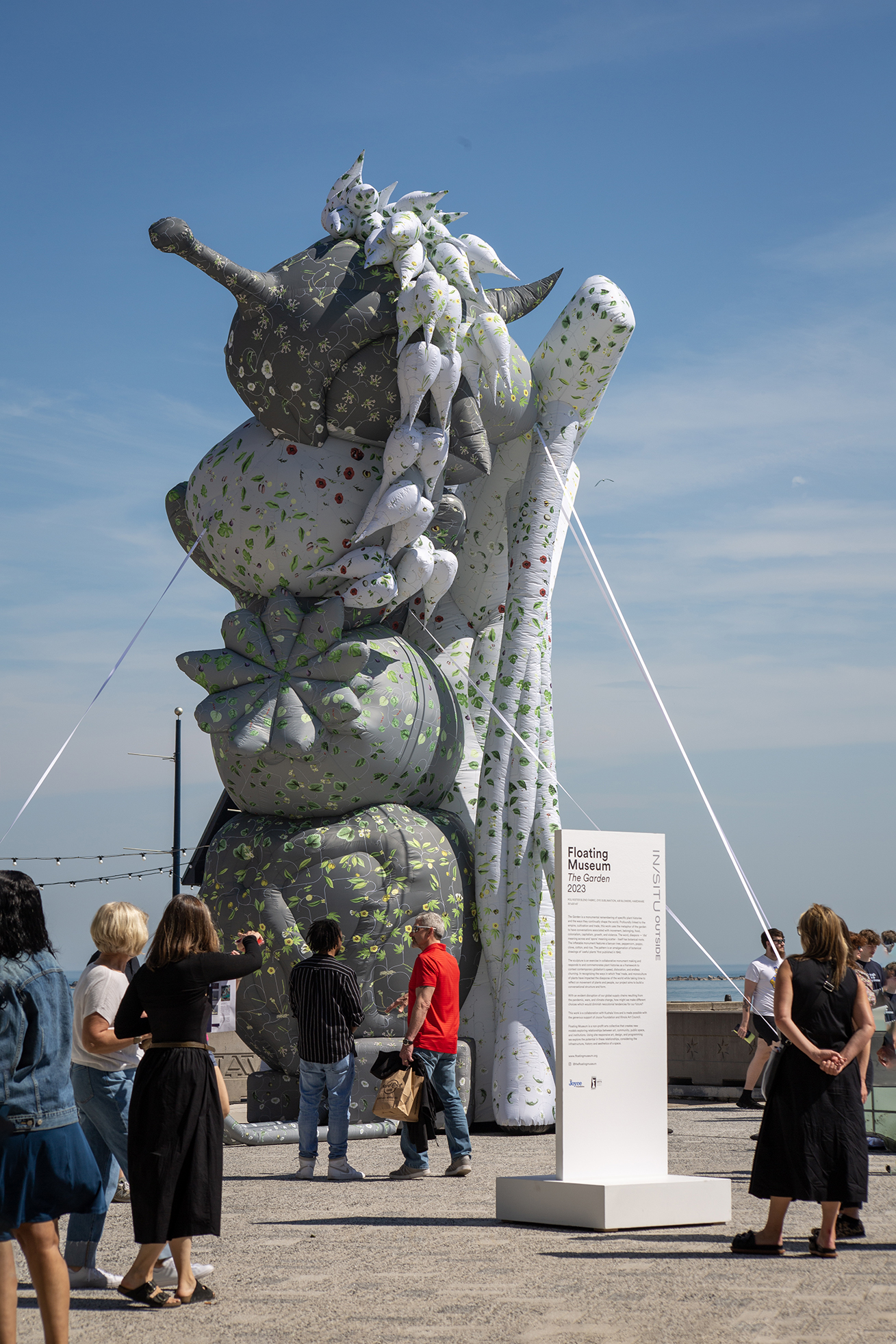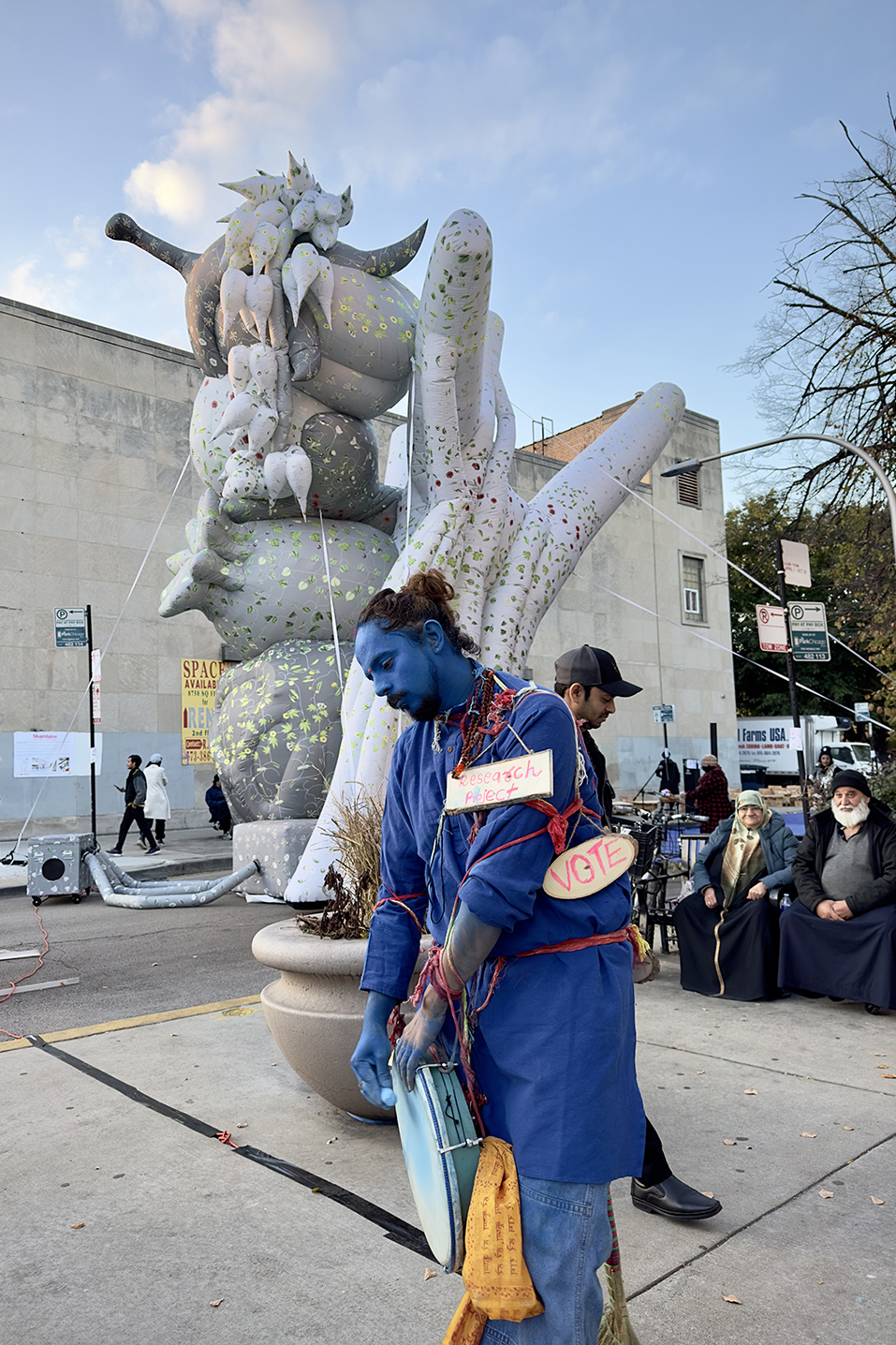













Description /
The Garden, 2022, polyester blend fabric, dye sublimation, air blowers, hardware, 30’x22’x12’
Floating Monuments: The Garden with Kushala Vora places the monument–an already complex, hybrid, and enigmatic object–at the center as a catalyst for conversation, scenographic intervention, and a performance platform. The project includes a new inflatable sculpture exhibit in Floating Museum's Floating Monuments series. Docents engage the general public during the day and the sculpture and platform transform into a performance series at night. A curated series of sets will explore project themes of diaspora, improvisation, and create a space for musicians and performers.
The project focuses on the role of plants as world makers. The ephemeral monument, platform and performance series serve as a catalyst for conversation about the movement of people and plants such as cotton, black pepper, poppy, rice and clove. The word, diaspora–'dia' meaning across and 'spora' meaning scatter–itself has botanical roots. Vasco Da Gama and Columbus sought out the Indian subcontinent for direct access to spices. This 'discovery’/exploitation of people and plants as 'resources' have continued to shape the way we see ourselves, each other and the landscape that we reside with. The monument aims to connect multiplicities through these routes of trade and passage.
Profoundly linked to the empire, cultivation and trade, plant types have shaped and continue to shape wide-reaching systems. With an evident disruption of our global supply chains resulting from the pandemic, wars and climate change, how might we make different choices which would diminish neo-colonial tendencies? The project aims to use the metaphor of garden to conjure up these themes and associated questions, and the ways in which they have affected ecological change, colonialism, capitalism, and violence. Additionally, the piece aims to blur the lines between dialogic platform, sculpture, and performance to model a pluralistic approach to monumentality.
If, like Rebecca Solnit writes in the 'Ruins of Memory' from 2007, the United States is a country that in many ways functions as a country without a past, an amnesiac landscape, a country filled with cities that are the eradication, even the ruin, of the landscape from which it rose, Floating Monuments: The Garden proposes a monumental remembering of specific plant's histories as a framework to contest contemporary globalism's speed, dislocation and endless churning. In recognizing the ways in which ‘free' trade, and monoculture of plants have shaped the diaspora's of the world while taking time to reflect on movement of plants and people, our project aims to build a conversational structure.
This project is made possible with the generous support of the Illinois Arts Council, and the Joyce Foundation.
The Garden, 2022, polyester blend fabric, dye sublimation, air blowers, hardware, 30’x22’x12’
Floating Monuments: The Garden with Kushala Vora places the monument–an already complex, hybrid, and enigmatic object–at the center as a catalyst for conversation, scenographic intervention, and a performance platform. The project includes a new inflatable sculpture exhibit in Floating Museum's Floating Monuments series. Docents engage the general public during the day and the sculpture and platform transform into a performance series at night. A curated series of sets will explore project themes of diaspora, improvisation, and create a space for musicians and performers.
The project focuses on the role of plants as world makers. The ephemeral monument, platform and performance series serve as a catalyst for conversation about the movement of people and plants such as cotton, black pepper, poppy, rice and clove. The word, diaspora–'dia' meaning across and 'spora' meaning scatter–itself has botanical roots. Vasco Da Gama and Columbus sought out the Indian subcontinent for direct access to spices. This 'discovery’/exploitation of people and plants as 'resources' have continued to shape the way we see ourselves, each other and the landscape that we reside with. The monument aims to connect multiplicities through these routes of trade and passage.
Profoundly linked to the empire, cultivation and trade, plant types have shaped and continue to shape wide-reaching systems. With an evident disruption of our global supply chains resulting from the pandemic, wars and climate change, how might we make different choices which would diminish neo-colonial tendencies? The project aims to use the metaphor of garden to conjure up these themes and associated questions, and the ways in which they have affected ecological change, colonialism, capitalism, and violence. Additionally, the piece aims to blur the lines between dialogic platform, sculpture, and performance to model a pluralistic approach to monumentality.
If, like Rebecca Solnit writes in the 'Ruins of Memory' from 2007, the United States is a country that in many ways functions as a country without a past, an amnesiac landscape, a country filled with cities that are the eradication, even the ruin, of the landscape from which it rose, Floating Monuments: The Garden proposes a monumental remembering of specific plant's histories as a framework to contest contemporary globalism's speed, dislocation and endless churning. In recognizing the ways in which ‘free' trade, and monoculture of plants have shaped the diaspora's of the world while taking time to reflect on movement of plants and people, our project aims to build a conversational structure.
This project is made possible with the generous support of the Illinois Arts Council, and the Joyce Foundation.

